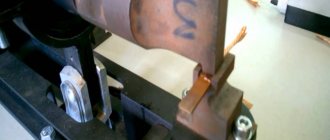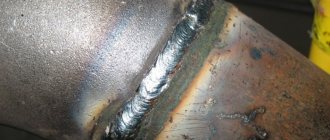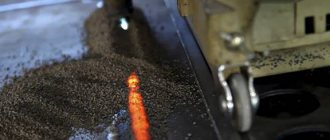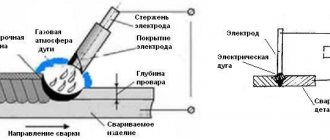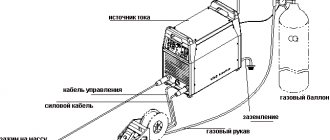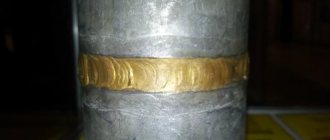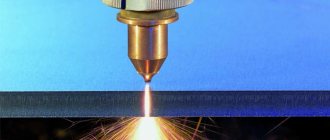High frequency welding
High-frequency welding
(
induction, radio frequency)
is a pressure welding method in which the edges of parts are heated by high-frequency current to the melting temperature.
The density of high-frequency current flowing through a metal body is maximum at the surface of the body and decreases sharply as it moves deeper into the body. This phenomenon is called the skin effect.
In addition, high-frequency currents flowing in two parallel conductors in opposite phases tend to approach each other.
This phenomenon is called the proximity effect.
Heating of parts during high-frequency welding is carried out using an inductor located at the joint being welded and generating induction currents in the welded edges, or using two electrodes sliding along the surface of the part. In both cases, the proximity effect and the surface effect make it possible to provide heating only in the surface layers of the joined edges with a depth of 0.1-0.15 mm. This reduces energy consumption and improves the quality of the welded joint, since overheating of the metal near the seam can be avoided.
When welding with high frequency currents (HFC), the product in front of the welding unit is formed in the form of a blank with a Y-shaped gap between the edges to be welded. To the edges using an inductor (Fig. 1.39, a)
or a rotating contact roller (Fig. 1.39.6), a high-frequency current is supplied so that it passes from one edge to the other through the place where they converge.
High frequency welding processes can be divided into three groups: pressure welding with fusion, pressure welding without fusion and pressure fusion welding without pressure.
Rice. 1.39.
Scheme of high-frequency welding of pipes using induction
(a)
and contact
(b)
current supply methods:
- 1, 11
— guide rollers;
2.8 -
ferrite rods;
3 -
inductor; - 4.7 -
compression rollers;
5, 6—
pipes;
9,10—
contacts
Pressure welding with flashing is carried out with preheating and local melting of the surfaces being welded. To obtain a high-quality welded joint, it is necessary that all melted metal present at the convergence of the welded elements be removed during upsetting. This process is implemented if the settling rate is sufficient and the molten metal does not lose its fluidity properties. A welded joint is formed between surfaces in a solid state. The heating rate reaches 15 • 10 4 °C/s, the sediment is 0.15-1.5 mm, the precipitation rate is 2000 mm/s. This method has found the widest application in the production of welded structures from ferrous and non-ferrous metals. The distance from the current supply point to the point where the edges converge usually ranges from 25 to 300 mm. In this segment, the workpieces being welded are heated.
Pressure welding without fusion is carried out with pre-heating of the welded surfaces to a temperature below the melting point of the metal being welded. The heating rate does not exceed 400 °C/s, the slump is 2.5–6 mm, the slump rate is 20 mm/s. Welding in the absence of a reducing environment can provide satisfactory joint quality only in a narrow temperature range and at deformations sufficient to destroy the oxide films on the surfaces being welded.
Fusion welding without pressure is carried out by heating the elements being welded until they melt. The products to be welded are tightly fitted to one another using flanged edges, which are heated and melted using an inductor. The pool of molten metal solidifies to form a weld without applying pressure. Heating rate is 250–3000 °C/s, power source current frequency is 70 and 440 kHz. This process is advisable to use for parts with a wall thickness of 0.3–1.5 mm and a maximum weld length of up to 500 mm. Characteristic of high-frequency welding processes is a pronounced localization of heating in combination with high welding speeds.
High-frequency welding is used to produce straight-seam pipes from unrefined hot-rolled low-carbon steel. The use of radio frequency (more than 400 kHz) makes it possible to weld longitudinal seams of pipes made of aluminum, heat-resistant alloys, and easily oxidized metals.
Applications
The most common application of RF welding is to seal thin sheets of polar thermoplastics such as PVC. Some products that commonly use RF welding include beach balls, air mattresses, life vests, book covers, and loose leaf folders. Radio frequency welding is also widely used to make medical products such as blood bags, disposable clothing, blood pressure cuffs, and packaging for certain items.[3] Radio frequency welding is most often used in the production of products that require a watertight or airtight seal. The process of sealing a weld or insertion tube creates seals that can withstand different types of requirements for certain types of fluid or air pressure. An example of this would be the medical industry, where ensuring a tight and watertight seal is critical. [7]
IV drip bag demonstrating RF welding around the perimeter.
general information
The method involves the use of laws and phenomena of physics.
- proximity effect;
- occurrence of electromagnetic forces;
- surface effect;
- influence on the distribution of current in the conductor of copper screens and magnetic cores;
- coil or ring effect;
- changes in the properties of metals with changes in magnetic field strength and temperature.
In high-frequency heating, the main role is given to the phenomenon of surface effect and proximity effect.
Surface effect
It consists in the uneven distribution of alternating current along the conductor profile (current penetration depth). The current density is highest at the outer surface and gradually decreases as one moves deeper. It is minimal in the center of the body.
Due to the surface effect, energy release is concentrated in the outer layers and the metal is rapidly heated. The proximity effect also contributes to this manifestation.
Proximity effect
It makes itself known by passing alternating current conductors through the system. In this case, each of the conductors is influenced by both its own alternating magnetic field and the field of other conductors.
The smaller the distance separating the conductors from each other and the higher the frequency of the current, the stronger the proximity effect.
This phenomenon contributes to increased energy concentration in the outer layer of the metal subjected to heating. Thus, the release of thermal energy occurs directly in the thickness of the metal, providing rapid heating in the welding zone and high efficiency of the heating method.
Species and groups
High-frequency welding, depending on the method of transferring energy to the edges, is classified into types:
- Contact . Contacts are placed on the welded edges, to which high-frequency current is supplied.
- Induction . Heating occurs using an inductor, when alternating current flows through it, a magnetic field is generated. When a metal part is placed in the middle of the inductor, an alternating magnetic flux will cause an induction current and heat will be generated in a given area.
HDTV welding processes are divided into 3 groups:
- Pressure with reflow . The mechanism consists in preheating the joined surfaces and their local melting. The molten material is removed from the welding zone during upsetting. A seam is formed between parts in a solid state.
- Pressure without melting . The surfaces to be welded are preheated to a temperature below the melting point of the metal being processed.
- Melting without pressure . The elements are heated until they melt. The weld pool of metal solidifies and a seam is formed without applying pressure.
Heating mechanism
Polarity is demonstrated using a water molecule.
The red shaded area around the oxygen atom is partially more negatively charged than the blue shaded area around the hydrogen atoms. In materials exposed to high-frequency alternating electric fields, four types of polarization can occur:[2]
- Electronic or electrical polarization is the redistribution of electrons
- Ionic polarization is the redistribution of charged particles - cations and anions.
- Maxwell-Wagner polarization is the accumulation of charge at the interfaces of inhomogeneous materials.
- Dipole polarization is the rearrangement of permanent dipoles.
Polarity of polyvinyl chloride (PVC) with an accumulated concentration of negative charge in red (around the more electronegative chlorine atoms) and a reduced concentration of negative charge in blue (surrounding the less electronegative hydrogen side of the molecule).
Dipole polarization is a phenomenon that is responsible for the heating mechanism in radio frequency welding of plastics. dielectric heating. When an electric field is applied to a molecule with an asymmetric charge distribution, or dipole, the electric forces cause the molecule to align with the electric field.[1] When an alternating electric field is applied, the molecule constantly changes its alignment, which causes the molecule to rotate. This process is not instantaneous, so if the frequency is high enough, the dipole will not be able to rotate fast enough to stay aligned with the electric field, resulting in random motion as the molecule tries to follow the electric field. This movement causes intermolecular friction, which generates heat.[3] The amount of heat generated by friction in a material depends on the field strength, frequency, dipole force, and free volume in the material.[1] Since the main driving force for dielectric heating is the interaction of the molecule's dipole with an applied electric field, high-frequency welding can only be performed on dipole molecules. The typical frequency range for dielectric heating is 10–100 MHz, but high frequency welding is typically performed around 27 MHz.[3] If the frequency is too low, the dipoles can align with the electric field and remain in phase with the electric current, minimizing the resulting intermolecular friction. This can also be described as minimal power loss from the electric field as the molecules will remain in phase and absorb minimal energy. When frequencies become high enough, power losses begin to increase as the dipoles cannot align with the speed of the return electric field. Dipoles become out of phase, absorbing energy, and this happens when heated. At a certain frequency, maximum power loss is reached, at which higher frequencies reduce power loss and cause less heating. The maximum dielectric power loss depends on the material.[4]
Principle of operation
The product blanks to be joined are installed at a slight angle to form a gap between the edges being joined. High-frequency current is supplied to the edges in one of the following ways - by an inductor or through sliding contacts and passes from one edge to the other through the zone of their convergence. The high concentration of energy in this zone is achieved as a result of the manifestations of the surface effect and proximity.
When the edges touch in the working area, the metal intensively heats up and melts. As a result of compression by crimping rollers, the metal is deposited and a strong connection is formed.
High Frequency Pipe Welding Process
